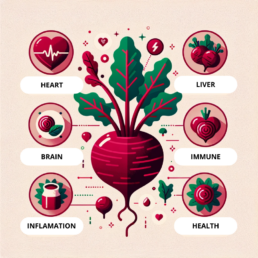Coronary Diet Intervention with Olive Oil
All about The Coronary Diet Intervention with Olive Oil Study.
The Evolution of Health Management Strategies
In the quest to combat cardiovascular health issues and diabetes, the synergy between diet and exercise has been super important. Traditionally, the focus has been primarily on weight loss through caloric restriction and increased physical activity. IN other words, less food, more exercise.
However, recent advancements in health research have shifted the paradigm towards a broader, more nuanced understanding. The need for lifestyle modification’s in health optimization has become clear. Many studies such as the Coronary Diet Intervention with Olive Oil and Cardiovascular Prevention (CORDIOPREV) are now highlighting many new ideas. For one, the importance of not just how much we eat or how much we weigh, but what we eat and how our hearts function. These insights mark a significant departure from conventional wisdom. This new outlook suggests a complex interplay of factors contributing to cardiovascular health and diabetes management beyond simple weight metrics.
Understanding the Study’s Core Aims
The CORDIOPREV study delves deep into the realm of dietary interventions. It brings a keen focus to preventing and managing type 2 diabetes mellitus (T2DM) and cardiovascular disease (CVD). Unlike traditional approaches that prioritize weight loss as the main goal, this study examines the impact of diet quality. Specifically a Mediterranean diet enriched with olive oil—and its effects on cardiovascular outcomes. By contrasting these dietary interventions with standard low-fat diets, the research provides invaluable insights. One of the insights is how enhancing diet quality and improving cardiorespiratory fitness can serve as potent alternatives or complements to the weight-centric strategies of the past.
This introduction and study overview aim to set the stage for a detailed exploration of how modern research is reshaping our approach to health management through diet and exercise.
The Importance of Diet Quality in Managing Health
Diet quality plays a crucial role in the prevention and management of cardiovascular diseases (CVD) and type 2 diabetes mellitus (T2DM). Studies have consistently shown that nutrient-dense diets rich in fruits, vegetables, whole grains, lean proteins, and healthy fats can significantly reduce the risk of chronic diseases. The Mediterranean diet, in particular, has been extensively studied for its benefits in improving heart health and glycemic control. This dietary pattern is high in vegetables, fruits, whole grains, legumes, nuts, and olive oil. It also includes moderate amounts of fish and poultry, and limits the intake of red meat and processed foods.
Scientific Findings on Diet Quality
Research indicates that the Mediterranean diet and other high-quality dietary patterns can lower the risk of CVD and T2DM by improving lipid profiles, reducing inflammation, enhancing insulin sensitivity, and promoting a healthy body weight. A study involving the Coronary Diet Intervention with Olive Oil and Cardiovascular Prevention (CORDIOPREV) trial demonstrated a significant reduction in major CVD events among participants following a Mediterranean diet enriched with olive oil compared to those on a low-fat diet.
Practical Tips for Enhancing Diet Quality
- Start with Vegetables and Fruits: Aim to fill half of your plate with a variety of colorful vegetables and fruits at every meal. These are rich in vitamins, minerals, fiber, and antioxidants.
- Choose Whole Grains: Opt for whole grains over refined grains. Examples include whole wheat, brown rice, oats, quinoa, and barley.
- Incorporate Healthy Fats: Include sources of healthy fats in your diet, such as olive oil, avocados, nuts, and seeds.
- Select Lean Proteins: Focus on lean protein sources like fish, poultry, legumes, and low-fat dairy products.
- Limit Added Sugars and Processed Foods: Reduce the intake of foods high in added sugars and heavily processed foods to minimize empty calories and unhealthy fats.
The Role of Exercise and Cardiorespiratory Fitness
Evidence Supporting Cardiorespiratory Fitness
Improved cardiorespiratory fitness (CRF) is associated with a lower risk of CVD and T2DM. CRF refers to the efficiency of the cardiovascular and respiratory systems in supplying oxygen to the muscles during sustained physical activity. High levels of CRF are linked to reduced body fat, improved insulin sensitivity, lower blood pressure, and a healthier lipid profile. Regular physical activity is the most effective way to enhance CRF, with benefits extending beyond physical health to include mental and emotional well-being.
Integrating Physical Activity for Better Health
Incorporating regular physical activity into one’s routine is essential for improving CRF and overall health. The American Heart Association recommends at least 150 minutes of moderate-intensity aerobic activity or 75 minutes of vigorous-intensity activity per week, or a combination of both. This can include activities such as walking, cycling, swimming, running, or group exercise classes. Additionally, incorporating strength training exercises at least two days per week can further improve muscle strength, bone health, and metabolic function.
Practical Suggestions for Enhancing Physical Activity
- Set Realistic Goals: Start with manageable goals and gradually increase the intensity and duration of your activities.
- Find Activities You Enjoy: Engaging in exercises that you find enjoyable increases the likelihood of consistency and long-term commitment.
- Incorporate Activity into Daily Life: Look for opportunities to be more active throughout the day, such as taking the stairs instead of the elevator, walking or biking for short trips, or standing up and moving during breaks at work.
- Stay Motivated: Setting goals, tracking progress, and having an exercise buddy can help keep you motivated.
Improving health through diet quality and physical activity is a multifaceted approach that requires commitment and consistency. By focusing on nutrient-dense foods and maintaining an active lifestyle, individuals can significantly reduce their risk of chronic diseases and enhance their quality of life.
Rethinking Salt and Heart Health: New Insights
For decades, common table salt has been cast as a major villain in the narrative of cardiovascular health. People interested in personal health and the like have avoided it. Today health professionals and dietary guidelines are cautioning against its excessive consumption. This is due mainly to the belief that it directly contributes to heart disease, hypertension, and stroke.
The conventional wisdom held that salt, or more specifically, the sodium it contains, was a primary culprit in raising blood pressure. This in turn is a significant risk factor for cardiovascular disease and something to be avoided by health conscious people. This stance led to widespread efforts to minimize salt intake as a preventative measure against heart-related conditions.
Historically, the relationship between salt and heart health was seen as straightforward. High salt intake was thought to increase blood pressure, which in turn, raised the risk of heart disease. This commonly held belief was supported by numerous studies and health organizations worldwide. They in turn advocated for reduced sodium diets as part of a heart-healthy lifestyle. Public health campaigns and dietary guidelines reflected this stance. It was common to hear them urging people to limit their consumption of salt-rich foods. People were warned about the dangers of the sodium content in processed foods and restaurant meals.
No One Size Fits All
However, as we shall see, recent research has begun to paint a more complex picture of the role of salt in cardiovascular health. Studies emerging in the last decade have challenged the one-size-fits-all approach to salt consumption. They are now suggesting that the impact of salt on heart health may not be nearly as detrimental for everyone as previously thought. These studies indicate that the relationship between salt intake and heart disease is more nuanced. It depends more on individual differences in salt sensitivity, genetic factors, and overall dietary patterns to name just a few variables.
One pivotal area of new research focuses on the concept of salt sensitivity. This sensitivity refers to the variation in how individuals’ blood pressure responds to salt intake. Some people experience significant increases in blood pressure with higher salt consumption. Others people however, show little to no change (salt-resistant individuals). This variability suggests that blanket recommendations for salt intake might not be appropriate for everyone. Again underscoring the need for personalized dietary advice based on individual health profiles and genetic predispositions.
Salt Studies
Recent studies have also explored the potential benefits of salt in the diet. Salt plays a crucial role in bodily functions. They include fluid balance, nerve transmission, and muscle contraction. It is also an essential electrolyte that helps with hydration and cardiovascular function. The nuanced view acknowledges that while excessive salt intake can be harmful. This is especially so for those with hypertension or pre-existing heart conditions. Moderate consumption within a balanced diet however, might not pose the same level of risk for healthy individuals.
The evolving perspective on salt and heart health is also prompting a reevaluation of how dietary guidelines are formulated. Instead of strict limits on salt intake for the entire population, some researchers are advocating for guidelines. These guidelines take into consideration the complexity of individual health needs and the overall dietary context. For example, the quality of the diet as a whole—rich in fruits, vegetables, whole grains, and lean proteins—may mitigate the potential negative effects of a higher salt intake.
A More Nuanced Approach
This shift towards a more nuanced understanding of salt’s impact on heart health emphasizes the importance of considering individual differences, the role of other dietary factors, and the balance of risks and benefits when making dietary recommendations. It reflects a broader trend in nutrition science towards personalized nutrition and the recognition that dietary advice must be adaptable to meet the diverse needs of the population.

Debunking Myths About Salt and Heart Health
The common narrative around salt and its effects on heart health has been a point of contention and misunderstanding within both the medical community and public perception for decades on end. Historically, salt has been labeled as harmful, primarily due to its association with high blood pressure, a well known risk factor for heart disease and stroke.
This belief and ubiquitous perspective was largely influenced by early observational studies and clinical trials that showed a reduction in blood pressure following a decrease in salt intake. As a result, dietary guidelines worldwide have recommended low-sodium diets as a universal strategy for reducing heart disease risk.
Historical Context of Salt’s Harmful Label
The view of salt consumption being a bad thing began taking shape in the latter half of the 20th century when researchers first started linking high sodium intake with elevated blood pressure. Public health policies were subsequently influenced by these findings, leading to the widespread promotion of salt-reduction strategies to combat heart disease and a heck of a lot of bad press for salt and sodium. The simplicity of the message – less salt equals better heart health – was appealing for its ease of understanding and implementation. However, this approach failed to account for individual variability and the complexity of dietary patterns contributing to cardiovascular health and is more “truthy” and truth.
Recent Research Challenges the Old Narrative
In recent years, a growing body of clinical research has begun to challenge the traditional dogma on salt. The idea that all individuals benefit from reducing salt intake is under attack. A seminal turning point came with the recent publication of studies. These studies are suggesting that the relationship between salt and heart health is not straightforward. For example, a series of articles published in the “New England Journal of Medicine” in 2014 highlighted the potential risks of both high and low sodium intake. These indicate and suggest a U-shaped relationship between salt consumption and health outcomes. This means that both excessive and insufficient salt intake could be associated with adverse health effects.
Moreover, the PURE (Prospective Urban Rural Epidemiology) study, one of the largest epidemiological studies to date, found that the association between sodium intake and cardiovascular events, as well as mortality, followed a J-shaped curve. This research indicated that while very high sodium intake was linked to increased heart disease risk, moderate intake was not, and very low intake might even be harmful.
Examples of Non-linear Relationship Studies
These findings underscore the complexity of the relationship between salt intake and heart disease risk. For instance, a meta-analysis published in the “Lancet” in 2016 analyzed data from over 130,000 individuals and concluded that low sodium intake was associated with an increased risk of cardiovascular events and death in individuals without hypertension. However this study has come under serious attack.
Conversely, only high sodium intake (exceeding 6 grams per day) was associated with an increased risk among those with high blood pressure.
Such evidence suggests a need to revisit and refine public health guidelines concerning salt consumption. Instead of a one-size-fits-all approach, there’s a growing consensus among scientists and nutrition experts for guidelines that consider individual health status, dietary context, and even genetic predispositions.
A Shift In Understanding
The shift in understanding underscores the importance of nuanced dietary advice and the need for continued research. We need to better identify those who may benefit from salt reduction . We also must identify those for whom too little salt may be just as concerning. This evolving narrative challenges long-standing dietary dogmas. It also opens the door for more personalized nutrition strategies that better reflect the complexities of human health.
Balancing Salt Intake for Optimal Heart Health
Achieving a balanced salt intake is crucial for maintaining heart health. Without unnecessarily restricting dietary pleasures, salt after all tastes good. Moderation and mindful consumption are key, alongside an understanding of how dietary quality and the source of salt can influence overall health outcomes.
Guidelines for Moderating Salt Consumption
- Understand Individual Needs: Recognize personal health factors, such as blood pressure levels and any history of heart disease, to tailor salt intake accordingly, you may or may not be sensitive to salt so some personal monitoring is advised.
- Aim for Moderation: The American Heart Association recommends no more than 2,300 milligrams a day, moving toward an ideal limit of about 1,500 mg per day for most adults.
The Role of Diet Quality and Salt Source
- Prioritize Whole Foods: Focus on fresh fruits, vegetables, whole grains, and lean proteins, which naturally contain lower amounts of sodium, while at the same time, not overdoing it on the sugars.
- Limit Processed Foods: These are the primary sources of high sodium in the diet, often containing much more salt than their natural or homemade counterparts, and are bad for you in so many other ways due to trans-fats and other ingredients.
- Choose Natural Salt Sources: When adding salt to foods, opt for unprocessed or minimally processed salts. Be mindful that all forms of salt have similar sodium content by weight, but natural sources may offer trace minerals.
Tips for Adding Flavor Without Excessive Salt
- Use Herbs and Spices: Enhance flavor with a variety of herbs, spices, citrus, vinegar, and garlic instead of relying solely on salt, there are many other flavors to choose from!
- Experiment with Salt-Free Seasoning Blends: Many blends can provide depth of flavor to dishes without adding sodium.
- Balance with Acidity: A splash of lemon juice or vinegar can brighten dishes, often reducing the need for added salt.
Practical Tips for Managing Salt Intake
Managing salt intake does not have to mean sacrificing flavor or enjoyment of food. By adopting some practical strategies, it’s possible to reduce sodium consumption while still enjoying a rich and varied diet.
Strategies for Reducing Reliance on Processed Foods
- Cook More at Home: Preparing meals from scratch gives you control over the amount of salt used.
- Choose Fresh or Frozen Produce: Opt for fresh or frozen fruits and vegetables, which are low in sodium, over canned varieties that may contain added salt.
- Select Low-Sodium Products: When buying processed foods, look for items labeled “low sodium,” “reduced sodium,” or “no salt added.”
How to Read Food Labels for Better Sodium Management
- Check the Sodium Content: Pay attention to the milligrams of sodium per serving and the number of servings per package.
- Understand Sodium Descriptors: Learn what terms like “sodium-free,” “very low sodium,” and “low sodium” mean in terms of actual sodium content.
Incorporating Potassium-Rich Foods to Balance Sodium Intake
- Eat Potassium-Rich Foods: Foods high in potassium, such as bananas, potatoes, spinach, and beans, can help counteract the effects of sodium and support healthy blood pressure.
- Understand the Sodium-Potassium Balance: A diet high in potassium can help to mitigate some of the negative effects of high sodium intake on blood pressure.
By embracing these guidelines and tips, you can find a healthy balance in your salt intake that supports heart health without diminishing the joy of eating. This approach encourages a more holistic view of diet, focusing on overall nutritional balance and the quality of ingredients, rather than simply cutting out salt.

Greens and Oral Health
Greens and Oral Health go hand in hand. Lear why below!
In the quest for optimal oral health, the importance of diet often takes a backseat to routine dental hygiene practices. Things such as brushing, flossing, and using mouthwash use. We rarely think about how our food can benefit oral health. Sure we know sugar is bad for oral health, but what about foods that prevent oral diseases and issues?
Emerging research suggests that what we eat is super important. This is particularly so for leafy greens, as they can play a crucial role in maintaining a healthy mouth. This article delves into the mechanisms through which leafy greens contribute to oral health, effectively acting as a natural mouthwash and preventative measure.
The Science Behind Leafy Greens and Oral Health
Leafy greens, including spinach, kale, arugula and lettuce, are rich in essential vitamins, minerals, and phytonutrients. Greens offer a plethora of health benefits. One of the key components found in leafy greens is dietary nitrates, which the body converts into nitric oxide. Nitric oxide has been shown to support opening and healing of the arteries and veins and blood flow. Its benefits extend much further however, particularly to the realm of oral health.
Amazing Nitrates
The nitrates found in leafy greens are a natural way to boost nitric oxide (NO) levels in the body. When consumed, these nitrates are converted by bacteria in the mouth and further in the stomach into nitrites. Eventually, the body converts these nitrites into nitric oxide. This process enhances blood flow, supports muscle function, and improves cardiovascular health by dilating blood vessels. Open blood vessels in turn lowers blood pressure and promotes circulation. Similarly, the consumption of certain amino acids, notably L-arginine and L-citrulline, found in foods like nuts, seeds, and meats, also promotes the production of nitric oxide. These amino acids are directly utilized by the body’s enzymatic pathways to synthesize NO, aiding in similar health benefits as those obtained from nitrates, including improved circulation and oxygen delivery to tissues.
The Two Paths To Nitric Oxide: Amino Acids & Nitrates

Mechanisms of Action: How Greens Helps Your Mouth
-
Saliva Production: Chewing leafy greens stimulates saliva production, which is the mouth’s natural way of cleaning. Saliva helps wash away food particles and neutralize acids produced by bacteria, thus protecting the teeth from decay and other similar bad things.
-
Antimicrobial Properties: Certain compounds in leafy greens possess antimicrobial properties that can combat oral pathogens. By inhibiting the growth of bacteria responsible for plaque formation and gum disease, leafy greens contribute to a healthier oral microbiome and better breath!
-
Anti-inflammatory Effects: The high levels of antioxidants and vitamins in leafy greens, such as vitamin C and E, can reduce inflammation in the gums, a key marker of gum disease.
-
Alkalizing Effect: Leafy greens help balance the pH levels in the mouth, creating an environment less conducive to harmful bacteria that thrive in acidic conditions.
Research Insights
Recent studies have highlighted the potential of leafy greens in promoting oral health. For instance, recent research has indicated that dietary nitrates in leafy greens can reduce the risk of gum disease. Furthermore, the fibrous texture of greens can aid in mechanically cleaning the teeth, similar to the action of brushing. Who needs a toothbrush when you have kale?
Incorporating Leafy Greens into Your Diet for Oral Health
Embracing leafy greens for oral health is simple and can be delicious. Here are some tips on how to incorporate them into your daily life:
-
Salads: A no-brainer way to consume more leafy greens. Experiment with different types of greens to keep things interesting.
-
Smoothies: Adding a handful of spinach or kale to your morning smoothie is an easy way to boost your intake.
-
Cooked Dishes: Incorporate greens into soups, stews, and stir-fries. Cooking can make certain nutrients more bioavailable.
-
Snacks: Kale chips or lightly steamed greens seasoned with herbs can be a healthy and tooth-friendly snack option.
In Conclusion
While not a replacement for traditional oral hygiene practices, incorporating leafy greens into your diet offers a complementary approach to maintaining oral health while at the same time supporting your heat health. Their natural antimicrobial, anti-inflammatory, and saliva-stimulating properties work synergistically to keep the mouth clean and healthy, akin to the benefits of using mouthwash. As research continues to uncover the intricate connections between diet and oral health, it’s clear that leafy greens are a powerful ally in the quest for a healthy mouth.
In the spirit of holistic health, embracing a diet rich in leafy greens is a simple yet effective step toward not just oral health, but overall well-being.
L-Arginine and Glaucoma and Nitric Oxide

Lets talk about L-Arginine and Glaucoma.
L-Arginine is a semi-essential amino acid known for its role in synthesizing nitric oxide and for cardiovascular health. Recently it has gained attention for its potential benefits in eye health. Of import are it’s roles in managing conditions like glaucoma and nonarteritic ischemic optic neuropathy (rNAION). Because of recent updates in science, we felt in necessary to update our reads on the advancements.
This article will be delving into the recent studies that illuminate Arginine’s promising role in these common eye conditions. We also are looking into how L-Arginine and Glaucoma are linked. Because our products focus on Nitric Oxide, we feel our readers need to understand these potential benefits.
L-Arginine’s Mechanism in the Eye
Arginine is converted into nitric oxide (NO) by nitric oxide synthase in the body. NO plays a crucial role in ocular health, particularly in regulating intraocular pressure (IOP) and blood flow to the optic nerve. It is known to be an ocular hypotensive agent. This suggests it has great potential in managing conditions like glaucoma, where IOP is a critical factor.
Impact on Intraocular Pressure and Glaucoma
A recent study on human eyes showed that L-Arginine significantly reduced the mean Intraocular Pressure (IOP) during infusion. Researchers attribute this decrease mainly to Nitric Oxide (NO) formation. However, IOP rose after the infusion stopped, suggesting the effect is temporary. This result is crucial for glaucoma management. L-Arginine and Glaucoma are linked and are a potentially intriguing combination of nutritional element versus disease.
Broader Implications for Glaucoma
In 2002, Finnish researchers evaluated L-Arginine in reducing eye pressure in glaucoma patients. They found that L-Arginine-nitric oxide supplementation led to a drop in eye pressure. Similarly, in 2007, Austrian researchers studied its effect not on eye pressure but on the rate of blood flow reaching the optic nerve. Because of this study they discovered that the nitric oxide created from L-Arginine improved blood flow to the nerve. This shows promise in reducing the risk of nerve damage. However, as of 2011, L-Arginine was not yet a recognized treatment for optic nerve damage.
L-Arginine in rNAION Treatment
rNAION, characterized by a sudden, painless loss of vision, is associated with poor blood flow to the optic nerve. A study explored the effectiveness of L-Arginine in a rodent model of rNAION. Both intravenous infusion after rNAION induction and oral pretreatment with L-Arginine significantly decreased optic disc edema in the acute stage and reduced the thinning of the inner retina, as well as the decrease in the number of retinal ganglion cells (RGCs). This indicates that L-Arginine can reduce anatomical changes in the eye and improve visual function in the acute stage of rNAION.
Practical Considerations and Future Research
Future research is necessary to establish definitive guidelines for its use in various eye conditions. The potential of L-Arginine in eye health, as evidenced by these studies, is significant, but further clinical trials and investigations are crucial to fully understand and harness its benefits.
In Conclusion
L-Arginine presents a promising avenue for the management and treatment of eye conditions. Particularly glaucoma and rNAION. While current studies offer promising results, the full potential of L-Arginine in eye health remains to be unlocked through further research. Its role in synthesizing nitric oxide and improving blood flow and pressure within the eye points towards a future where it could become a key component in eye health management strategies.
References
- “The effect of L-arginine on intraocular pressure in the human eye” – https://pubmed.ncbi.nlm.nih.gov/10980664/.
- “L-Arginine and Glaucoma” – https://healthfully.com/l-arginine-and-glaucoma-7433644.html
- “Effects of L-arginine on anatomical and electrophysiological deterioration of the eye in a rodent model of nonarteritic ischemic optic neuropathy” – https://pubmed.ncbi.nlm.nih.gov/23712653/
What are the benefits of taking beetroot supplements?
What are the benefits of taking beetroot supplements?
Welcome to the vibrant, red, purple, and somewhat underrated world of beetroot, a true nutritional powerhouse that’s more than just a splash of color on your plate or in your juicer.
Beetroot, or as some like to call it, nature’s powerhouse, is packed with an array of vitamins and minerals; it literally contains a treasure trove of health benefits built-in vegetable form.
Now, let’s dive a bit deeper, shall we? We’re not just talking about beetroot in its raw or cooked state; nope, we’re venturing into the realm of beetroot supplements – a concept catching on for its convenience and concentrated goodness. Raw, potent, and loaded with heart-healthy nutrients, beetroot supplements are taking off; let’s discover why!
What are the benefits of taking beetroot supplements for improved cardiovascular health?
Beetroot supplements have garnered significant attention recently and in the past for their cardiovascular benefits.
The secret lies in their high nitrate content, which the body converts into nitric oxide. This compound plays a crucial role in regulating blood vessel dilation, thereby enhancing blood flow and reducing the strain on the heart to name just a few of it’s important functions.
Beetroot Studies
Studies have shown that the regular intake of beetroot supplements can lead to improved heart health. For instance, research published in the Journal of Nutrition demonstrated that beetroot supplementation resulted in lower blood pressure and arterial stiffness, two key factors in maintaining and keeping cardiovascular health. Additionally, the beetroot’s antioxidant properties help reduce oxidative stress, which is a major contributor to heart disease.
Benefits Of Beetroot
The benefits of taking beetroot supplements regularly extend to the reduction of bad cholesterol levels while simultaneously increasing good cholesterol. This balance is vital for preventing plaque buildup in arteries, a leading cause of heart attacks, strokes, and death, especially in the West.
Folate In Beetroot
Furthermore, the presence of compounds like betaine and folate in beetroot aids in reducing homocysteine levels, high levels of which are associated with an increased risk of cardiovascular diseases.
What are the benefits of taking beetroot supplements for enhanced athletic performance?
Beetroot supplements have become a popular ergogenic aid among athletes, ergogenic meanins ( helps with sports) .
The nitrates in beetroot are converted into nitric oxide, which enhances blood flow to muscles, improving oxygen and nutrient delivery and enhancing sports performance.
Boosting Sports Performance
This process is particularly beneficial during high-intensity workouts or endurance sports, where efficient oxygen utilization is critical for performance. A study in the Journal of Applied Physiology found that athletes who consumed beetroot supplements before exercising experienced significant performance improvements and delayed fatigue.
The benefits of beetroot supplements in athletic and sports performance also include faster recovery times.
Beetroot Is Anti-inflammatory
Beetroot’s anti-inflammatory and antioxidant properties help reduce muscle soreness and aid in quicker recovery post-exercise. Athletes consuming beetroot supplements have reported feeling less muscle pain and faster return to peak performance levels after strenuous workouts. The improved blood flow also contributes to better thermoregulation during exercise, allowing athletes to maintain optimal body temperature and performance.
What are the benefits of taking beetroot supplements for blood pressure regulation?
The regulation of blood pressure is another key benefit of beetroot supplements, but as a caveat, only the highest quality ones really work well; more on that later.
High blood pressure, or hypertension, is a common health concern that can lead to severe health complications if left unmanaged. The nitrates in beetroot are effective in dilating blood vessels or opening them, which helps lower blood pressure.
Blood Pressure
A meta-analysis in the Journal of Nutrition highlighted the significant impact of beetroot juice supplementation in reducing systolic and diastolic blood pressure.
The impact of beetroot supplements on blood pressure is particularly beneficial for individuals with hypertension or those at risk of developing cardiovascular diseases. By improving endothelial function, which is the ability of blood vessels to dilate, beetroot supplements contribute to overall cardiovascular health. Moreover, the potassium content in beetroot also plays a role in blood pressure regulation by balancing out the negative effects of sodium.
Cardiovascular Health
The mainstream benefits of beetroot supplements encompass improved cardiovascular health, enhanced athletic performance, and effective blood pressure regulation. These benefits stem from the high nitrate content of beetroot, which the body converts into nitric oxide, improving blood flow and oxygen delivery and supercharging the heart. The antioxidant and anti-inflammatory properties further contribute to heart health and recovery post-exercise.
As a natural supplement, beetroot offers a convenient and effective way to enhance overall health and well-being.
Exploring the Lesser-Known Benefits of Beetroot Supplements
Beetroot is known for its deep crimson color and earthy flavor. It’s often consumed for its taste and nutritional value, but what’s less known are the remarkable health benefits of beetroot supplements, especially relating to cognitive health, anti-inflammatory effects, and liver health.
Cognitive Health: Improving Brain Function and Reducing the Risk of Dementia
- Mechanism of Action
- Beetroot is rich in nitrates, which the body converts into nitric oxide. Nitric oxide is crucial for maintaining vascular health; this includes the super-important cerebral arteries.
- Improved blood flow to the brain enhances oxygen and nutrient delivery, which is essential for optimal brain function. An oxygen-rich brain is a healthy brain.
- Research Findings
- Studies have shown that beetroot supplementation can enhance cognitive function, particularly in older adults. This may make it a very useful friend of elderly adults.
- A study published in the “Journal of Gerontology” found that dietary nitrate, like that which is derived from common beetroot, improved the blood flow to the frontal lobes of the brain, an area often associated with cognitive decline as we age.
- Potential in Dementia Prevention
- Regular intake of beetroot supplements may reduce the risk of dementia by maintaining healthy blood vessels in the brain.
- Beetroot supplements offer neuroprotective benefits by reducing oxidative stress and inflammation, which are key contributors to cognitive decline.
Anti-Inflammatory Effects: How Beetroot Combats Inflammation
- Bioactive Compounds
- Beetroot contains various anti-inflammatory compounds like betalains, which give it its red color that we all know and love. These fantastic compounds have been shown to inhibit specific signaling pathways that lead to inflammation.
- It also contains a good amount of folate and magnesium, known for their anti-inflammatory properties.
- Clinical Evidence
- Research indicates that beetroot can significantly reduce markers of inflammation. A study in the “Journal of Inflammation” noted that beetroot supplementation reduced C-reactive protein levels, a marker for inflammation, in participants.
- Applications in Chronic Conditions
- Chronic inflammation is a root cause of many diseases, including heart disease, arthritis, and certain cancers. Regular consumption of beetroot supplements can play a role in managing and preventing these conditions.
Impact on Liver Health: Detoxification and Liver Function Support
- Detoxification Properties
- The liver is crucial for detoxification in the body, and this particular aspect of beetroot is often ignored. Beetroot contains compounds that stimulate the liver’s detoxifying enzymes.
- Glutathione, a key detoxifying agent, is increased by the consumption of beetroot, aiding in eliminating toxins.
- Supporting Liver Function
- Beetroot is high in antioxidants, which protect liver cells from oxidative stress and damage.
- Studies suggest that the regular intake of beetroot can help in the treatment of liver diseases, including fatty liver disease.
- Enhancing Liver Health
- The dietary fiber in beetroot aids in digestion and helps in maintaining liver health by preventing fatty deposits.
- Beetroot also helps in balancing internal pH and stimulating bile production, which further aids liver function.
Clear Health Benefits
Beetroot supplements offer an array of lesser-known but significant health benefits, especially in enhancing cognitive function, combating inflammation, and supporting liver health. While it is widely recognized for its ability to improve athletic performance and cardiovascular health, these additional benefits make it an invaluable addition to a health-conscious individual’s diet.
The cognitive benefits, in particular, are promising, offering potential in the fight against age-related cognitive decline and dementia. Its anti-inflammatory properties make it a natural and effective option for managing chronic inflammation and associated diseases. Moreover, its impact on liver health, a crucial organ for detoxification and metabolism, is an area of increasing interest.
If you would like to know more, join our newsletter!
The Horse Chestnut For Heart Health: A Historical and Therapeutic Overview
Introduction
The horse chestnut, an important ingredient in many heart and circulation support formulas today. It is commonly used for promoting heart health. Its scientific name is Aesculus hippocastanum and is so much more than just the big tree you may have seen in a park. This article delves into the fascinating journey of the horse chestnut. We will be tracing its roots from historical significance to its role in today’s health practices. Our focus will be particularly in the realm of heart support.
The horse chestnut is known for its distinctive spiny fruits and brown seeds. They are often playfully referred to as “conkers”. The horse chestnut is significant in various cultures and traditional practices. Its story is rich with folklore, medicinal applications, and a longstanding presence in human history.
Ancient Remedies
We will explore how these historical uses have turned into modern medicinal applications. Also, we will be shedding light on this remarkable tree’s enduring relevance. Our aim will be helping you understand when and how to use it and explain its heart supporting role.
From ancient remedies and cures to current scientific research it has a long history of use. The horse chestnut’s journey is a testament to the interplay between nature and human health. This introduction sets the stage for a comprehensive exploration of the horse chestnut’s popular use. Its promising future in supporting heart health is also of interest.

Origins and Taxonomy
The horse chestnut, known scientifically as Aesculus hippocastanum, is a tree that has captivated attention both for its beauty and its medicinal properties. In this section, we delve into its scientific classification and origins. We will be tracing the journey of this remarkable tree from then old times to present. Horse Chestnut has widespread distribution across various landscapes worldwide. Here is a little more about it:
Scientific Classification
- Kingdom: Plantae – Denoting its status as a plant.
- Clade: Angiosperms and Eudicots – Indicating it’s a flowering plant with a specific seed structure.
- Order: Sapindales – A group known for species like maples and lychee.
- Family: Sapindaceae – A family that includes a variety of flowering plants.
- Genus: Aesculus – This genus comprises all horse chestnut species.
- Species: A. hippocastanum – The specific scientific name for the horse chestnut.
Origins
The horse chestnut likely originated from the Balkan Peninsula in Southeast Europe. It was not native to the British Isles but arrived there in the late 16th century. After its introduction, it quickly gained popularity worldwide for its ornamental value and natural beauty.
Geographic Distribution and Natural Habitat
The horse chestnut first appeared in the mountainous regions of Greece and Albania. It has since been widely cultivated across Europe and other parts of the world. Its ability to adapt to different soil types and climates has led to its widespread cultivation and use. Today, you can find it in temperate regions of Europe, North America, and parts of Asia.
In its natural habitat, the horse chestnut prefers moist, fertile soils. It commonly populates parklands and large gardens. It thrives in full sun but also tolerates semi-shaded areas. This makes it a highly adaptable species for various landscapes and locations.
This tree’s journey from the mountainous regions of the Balkans to its present-day global presence is a story of botanical migration. It is also one of human appreciation for its aesthetic and practical value. The horse chestnut’s adaptability not only to different terrains but also to cultural uses is significance. It underscores its role as a botanical traveler and a cherished component of the natural world.
Historical Uses and Cultural Significance
The horse chestnut tree has a rich tapestry of uses and significance woven through its rich history. This section explores its traditional roles in folk medicine, its cultural impact across different regions, and how its usage has evolved over time.
Traditional Uses in Folk Medicine and Early Medicine
Early Medicinal Applications
People traditionally used various parts of the horse chestnut tree, especially the seeds, leaves, and bark, in folk remedies across different regions. Practitioners highly valued the seeds for their effectiveness in treating varicose veins and hemorrhoids. Folk practitioners also turned to horse chestnut for its anti-inflammatory properties to reduce pain and swelling. This makes it a popular ingredient in many excellent nitric oxide products, as inflammation in the arteries can harm your heart. In some cultures, people used the tree’s components to address respiratory issues and fever. This is important since pulmonary and heart health are closely linked.
Cultural Significance in Different Regions
Europe: In its native Balkans and across Europe, the horse chestnut symbolizes strength and endurance. Its blossoming signaled the arrival of spring and featured prominently in local folklore.
British Isles: After its introduction, it became a staple in British gardens and parks, with ‘conkers’ becoming a cultural staple among children.
North America: Introduced later in North America, the tree is appreciated for its ornamental value, adding aesthetic beauty to parks and streets, just as in Europe.
Evolution in Usage Over Time
- From Folk Remedy to Scientific Study: The transition of horse chestnut from a folk remedy to a subject of scientific research marks a significant evolution. Modern medicine has taken interest in its active compound, aescin, for its potential therapeutic benefits.
- Contemporary Herbal Medicine: Today, horse chestnut extracts are widely used in herbal medicine, especially in Europe, for treating circulatory problems. They are increasing in use in the US as well, and form an important part of many heart health products.
- Changing Perceptions: The perception of the horse chestnut has shifted from a common tree to a valuable medicinal resource, with ongoing research exploring new therapeutic applications and tons of products, including its use today.
This historical journey of the horse chestnut, from traditional folk medicine to contemporary medicinal applications for blood pressure and heart support, highlights its therapeutic potential and cultural resonance across different European societies. China on the other hand merrits its own section and we will discuss that below.

The Use of Horse Chestnut in Traditional Chinese Medicine
The use of horse chestnut in Traditional Chinese Medicine (TCM) involves several species related to the European horse chestnut (Aesculus hippocastanum), most notably Aesculus chinensis and Aesculus wilsonii.
These species have been used in TCM for various health concerns, particularly their properties in improving circulation and reducing inflammation, which are vital components of heart health. Here’s a detailed overview of their use in TCM:
When and How It Started:
- Historical Roots: The exact origins of using horse chestnut in TCM are not well-documented, but it likely dates back centuries, as TCM has a long history of using a wide array of plant-based remedies.
- Integration into TCM: These species were integrated into the extensive list of herbal cures of Chinese Medicine, noted for their unique properties aligning with TCM’s natural approach to health.
Who Used It:
- TCM Practitioners: Chinese doctors and herbalists have used parts of the horse chestnut tree, including seeds, leaves, and bark, for various treatments.
- Common Usage: It was used by individuals seeking traditional remedies for ailments related to circulation, inflammation, and other related health issues.
Medicinal Uses and Why:
Circulatory Health:
Blood Movement and Stasis: Horse chestnut species in TCM are known for their ability to move and tonify blood, and remove stasis. This makes them useful for conditions like thrombosis and hemorrhoids.
Treating Venous Disorders: They are particularly effective in treating conditions related to venous insufficiency, such as varicose veins and leg cramps.
Other Health Benefits:
Anti-inflammatory: Used to reduce edema and bloating and to treat conditions like rheumatism and neuralgia.
Respiratory and Digestive Health: People use them as an expectorant for respiratory problems and to alleviate abdominal pain.
Women’s Health: People use the seeds and other parts to moderate menses, stop excessive uterine bleeding, and alleviate premenstrual symptoms.
How It’s Used:
Various Forms: Horse chestnut in TCM is being used in different forms, including extracts, oils, and as part of herbal mixtures.
External and Internal Applications: Applying it externally is also possible (like oils for rheumatism) or taken internally for systemic health issues.
Cultural Context:
Holistic Approach: In TCM, the use of horse chestnut is not just about treating specific ailments but is integrated into a natural approach to health, balancing the body’s Qi, and aligning with the principles of Yin and Yang.
This overview shows how horse chestnut species have been adopted and utilized in TCM, reflecting the system’s rich tradition of herbal medicine and its more basic approach to health and wellness.
Cardiovascular Support and Medical Research Today
Therapeutic Properties
Mechanisms of Action in Heart Health: How it works!
Venotonic Effect: Horse chestnut strengthens veins, increasing their elasticity and tone. This is crucial for health of the heart. Improved vein elasticity positively impacts blood pressure and heart health. It does so by improving blood flow to the heart. The helps by reducing the risk of conditions like venous insufficiency and varicose veins and so much more.
This efficiency in the venous system reduces the workload on the heart and can help maintain healthier blood pressure levels. Additionally, more elastic veins are less prone to blood clot formation. This is crucial for stopping some serious health issues. Among the most common is deep vein thrombosis. Overall, the health of veins is a key component in the broader picture of cardiovascular wellness.
Reducing Venous Return: It helps reduce the return of blood from veins in the legs to the heart, thereby decreasing venous pressure and swelling.
Anti-inflammatory Properties: It reduces inflammation in the veins, a key factor in many diseases.
Anti-inflammatory and Venotonic Effects:
Reduction of Edema: The anti-inflammatory properties help reduce swelling and edema, often associated with poor circulatory health.
Improving Blood Flow: By toning veins, horse chestnut improves overall blood flow, a vital aspect of heart wellness.
Clinical Studies and Research
Summary of Significant Studies:
Studies have shown that horse chestnut extract effectively reduces symptoms of chronic venous insufficiency. These include swelling, pain, and fatigue in the legs.
Research indicates its effectiveness in treating varicose veins, similar to compression stockings.
Comparative Analysis with Conventional Treatments:
Horse chestnut extract is similar to other treatments like compression therapy. In tests, giving favorable results in terms of efficacy and patient compliance.
Other Medicinal Uses
Broader Medicinal Applications
Use in Treating Venous Insufficiency and Varicose Veins:
Beyond cardio support, people today are using it for the treatment of venous insufficiency and varicose veins.
Potential Benefits for Other Health Conditions:
It may also be beneficial for hemorrhoids, post surgery edema, and as a potential anti-inflammatory agent for joint pain.
Safety and Side Effects
Potential Side Effects and Contraindications:
Common side effects are dizziness, headache, and gastrointestinal upset.
Individuals with liver or kidney disease, or pregnant or breastfeeding women, should not use it without medical advice.
Guidelines for Safe Usage:
Users should adhere to the recommended dosage and use it long-term only under a doctors guidance.
As with any supplement, individuals should use it as part of an overall health plan, not as the sole treatment for serious conditions.
In summary, both historical use and modern clinical studies support the applications of horse chestnut in heart health and beyond.
Its efficacy, particularly in venous conditions, is a valuable addition to herbal medicine. However, like any therapeutic agent, understanding its safety profile and potential interactions is crucial for its responsible use.
Ultimate Nitric Oxide Nutrition With Horse Chestnut
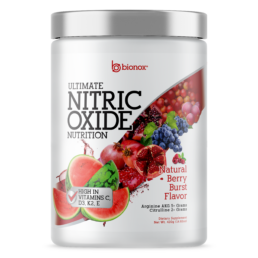
How to Choose A Good Beetroot Supplement
Are you searching for a good beetroot supplement that delivers real results? Look no further than Beetroot Energy by Bionox!
In the world of heart health and blood pressure support supplements, not all products are created equal, especially beetroot products. Many beetroot powders on the market boast health benefits but fall short due to their negligible nitrate content, the very compound that makes beetroot a super-food.
What are nitrates?
Nitrates are naturally occurring compounds found in the soil and water that plants often absorb as they grow. In vegetables like beets, spinach, and arugula, nitrates are beneficial because they convert to nitric oxide in the body, which helps to relax and dilate blood vessels, improving blood flow and reducing blood pressure just to name a few of the many many amazing things it can do.
This can enhance exercise performance and cardiovascular health and so much more.
Nitrates In Bacon
In processed meats like bacon, added nitrates can form nitrosamines during high-heat cooking, which are potentially carcinogenic. This is not the same as the nitsates in beets. Consuming high amounts of these types of nitrates can increase the risk of diseases, including certain types of cancer. The key difference is in the formation of harmful compounds in processed meats, as opposed to the beneficial nitric oxide produced from vegetable nitrates.
Our Natural Nitrates
Beetroot Energy stands out from the crowd of junk beetroot products. Unlike cheaper powders that often contain little to no natural nitrates, Beetroot Energy guarantees a full 100mg of healthy, natural beetroot nitrates in every serving.
Natural nitrates are the powerhouse behind beetroot’s health-boosting properties, especially known for enhancing blood flow, improving stamina, and supporting cardiovascular health, they are a health promoting powerhouse for your body.
Unlike synthetic nitrates as mentioned above, which are commonly found in processed meats and have a notorious reputation for health risks, the natural nitrates in Beetroot Energy are derived from beets grown in nitrate-rich soil, ensuring their efficacy and safety. With Beetroot Energy, you don’t just get a supplement; you get the full spectrum of beetroot’s advantages in a delicious, convenient cherry tart that requires no preparation or mixing.
Potent Natural NO Simulators
Beetroot Energy’s nitrate-rich formula is designed to increase vasodilation, enhancing not just muscle strength and endurance but also promoting better skin tone and cognitive function. It’s a versatile supplement that fits seamlessly into your daily routine, providing sustained energy whether you’re at the gym or powering through your workday.
In the health and wellness world, many of the most poorly made beetroot supplements are lauded for their potential benefits, including improved stamina and cardiovascular health. While it’s true beetroot can do those things, their cheap products lack the critical element that makes those things happen.
The critical factor often overlooked in these supplements: the actual nitrate content. Nitrates as mentioned already are the powerhouse behind beetroot’s health benefits, and unfortunately, many supplements on the market fall short in delivering these vital compounds.
Understanding Beetroot Supplements: The Nitrate Dilemma Different farming methods product different amounts on nitrates. The care, feeding and growing of higher nitrate beets costs more money, so most companies do not use these more expensive beets. They use beets with almost ZERO nitrates content.
The Low Down on Junk Beetroot Supps
Capsules
- Capsules are a popular form of beetroot supplements, convenient for those on the go. However, many of these capsules contain merely dried and ground beetroot, which significantly lacks in nitrate content compared to fresh or properly processed and grown options. Look to see if you can see nitrate amount listed on package. You almost never will. Why? Because it’s ZERO, ZILCH.
Powders
- Beetroot powders are another common supplement choice for many. Marketed for their ease of use in shakes and smoothies, they suffer a similar fate to capsules. The drying process can reduce nitrate levels, and some brands add fillers, further diluting the potential health benefits.
Drinks
- Ready-to-drink beetroot juices and concentrates might seem like a good source of nitrates, but the devil is in the details. Many of these drinks are not only diluted but also contain added sugars and preservatives, undermining the nutritional value of the beetroot itself.
The Inconvenient Truth: Beetroot as a Filler
- Beetroot’s cost-effectiveness has led to its use as a filler ingredient, even in products like dog food. This speaks volumes about its abundance and affordability but raises questions about the quality and efficacy of beetroot in many supplements. THis dog food grade beetroot is what most companies are selling you!
Seeking Genuine Nutrition: What to Look for in Beetroot Supplements
- When searching for a beetroot supplement, the key is to look for products that specify their nitrate content. Supplements that use concentrated beetroot extract or those processed to retain nitrates are more likely to deliver the health benefits associated with beetroot.
The world of beetroot supplements is riddled with products that capitalize on the vegetable’s healthy image without delivering its full benefits. As consumers, it’s crucial to understand the difference between mere beetroot presence and the actual delivery of nitrates. By choosing supplements with specified nitrate content, we can ensure that we’re not just falling for marketing hype but genuinely investing in our health.
Use The Right Kind Of Beets!
Many people find it challenging to incorporate beetroot into their diets due to its strong, sometimes nasty, earthy taste which can be quite overpowering. This can make it hard for some to enjoy the benefits of beetroot, despite its terrific and powerful health advantages.
Bionox’s Beetroot Energy lozenges, referred to as tarts, offer a palatable alternative. They are infused with a natural cherry flavor that transforms the typically robust taste of beetroot into a delightful treat. This makes it easier and more enjoyable for individuals to consume beetroot and gain its cardiovascular and endurance benefits without having to deal with its naturally strong flavor.
When to take Beetroot Energy?
The best time to take Beetroot Energy tarts is in between meals, perhaps 20 minutes before or after eating. This timing allows the body to optimally break down the beneficial ingredients in Beetroot Energy for maximum absorption. Taking apple cider vinegar before consuming may also help according to some research.
Is It Safe?
Beetroot Energy tarts are safe for most individuals, unless you have an allergy to beets, they present a clean and easy way to support your health.
Are There Studies on Beetroot?
Regarding studies, nitrates found in vegetables like beetroot have been studied extensively. Research suggests that dietary nitrates can lower blood pressure, improve athletic performance, and enhance blood flow due to their conversion to nitric oxide in the body.
Here are some links to a few studies on nitrates.
Increasing vegetable intake to obtain the health promoting and ergogenic effects of dietary nitrate” from the European Journal of Clinical Nutrition: Study Link. This study discusses the benefits of increased dietary nitrate intake from vegetables, highlighting its cardio-protective effects and improvement in exercise performance.
Nitrate containing vegetables and dietary nitrate and nonalcoholic fatty liver disease: a case control study” from the Nutrition Journal: Study Link. This study explores the relationship between dietary nitrate intake from vegetables and nonalcoholic fatty liver disease.
Nitric Oxide & Dietary Nitrate: Another Reason to Eat Your Vegetables” – Center for Nutrition Studies: Study Link. This article discusses the relationship between dietary nitrate and nitric oxide, emphasizing the importance of eating vegetables for health benefits.
When it comes to choosing a Good Beetroot Supplement, it’s essential to consider the nitrate content, as this is the key component that contributes to the health benefits of beetroot. Many products on the market claim to offer the advantages of beetroot, but few deliver the necessary nitrate levels. In our comprehensive guide, we’ll explore what makes a beetroot supplement effective and how to identify the ones that truly offer the benefits they claim.
Choosing the Right Beetroot Supplement
Benefits
Increased and sustained energy
Supports increased strength and endurance
Oxalate free, natural, tested and safe
Increases vasodilation for harder, more vascular-looking muscles (great for gym pumps)
Increased blood flow supports improvements in health, cognition, and skin tone and tightness
Convenience and Taste
Unlike beetroot powders, Beetroot Energy is an easy-to-use, delicious cherry tart that requires no mixing or preparation. Our natural cherry flavor is fantastic and is loved by our customers!
A Personalized Heart Health Diet and Supplement Guide
Heart Health Diet Guide.
Introduction to the Heart Health Diet: Basics and Benefits
Preventing heart disease is significantly easier and more effective than treating it once it’s completely developed in your body. This is a crucial point to understand, as heart disease remains a leading cause of disease and mortality worldwide. One of the most powerful tools in preventing heart disease is, as you may already know, a healthy diet. Making simple dietary changes can also have a profound impact on your heart health.
Firstly, prevention is key because once heart disease sets in, treatment can become complex and challenging. It often involves long-term risky medication, difficult lifestyle adjustments, and, in severe cases, surgical interventions. The financial, physical, and emotional costs of treating heart disease are high. This is true not just for the individual, but also for their families and the healthcare system.
In contrast, preventive measures, particularly through diet, are relatively simple and accessible. A heart-healthy diet includes many fruits, vegetables, whole grains, and lean proteins. It also means limiting the intake of processed foods, sugars, and unhealthy fats. Incorporating such foods into your diet can help maintain a healthy weight. They help lower cholesterol levels, reduce blood pressure, and decrease the risk of type 2 diabetes—all contributing factors to heart disease.
Moreover, adopting a heart-healthy diet doesn’t have to be a drastic or unenjoyable change. It’s about making smarter food choices and being mindful of portion sizes. Simple swaps like choosing whole grains over refined ones or choosing fish or plant-based proteins instead of red meat can make a big difference.
Important Choices
The choices we make in our diet not only affect our present health but also determine our risk for heart disease in the future. It’s about creating a sustainable and enjoyable eating pattern that supports heart health over a lifetime. Prioritizing a heart-healthy diet is an investment in your long-term health. This is so because it is better to manage heart disease before as opposed to after it has developed.
Regarding heart-healthy diets, the key is to focus on foods that support cardiovascular health while being mindful of those that could be harmful. It’s important to note that some seed oils, often considered healthy, can be inflammatory. This is a nuanced area, and opinions differ, but it’s something to consider when choosing fats in your diet.
Things You Can Do
- Caloric Balance and Physical Activity: Balancing calories is fundamental. Consuming as many calories as you burn is key to maintaining a healthy weight. Regular physical activity, as recommended by the American Heart Association, includes at least 150 minutes of moderate activity or 75 minutes of vigorous activity weekly, along with muscle-strengthening activities.
- Healthy Dietary Pattern: Emphasizing a variety of fruits and vegetables, whole grains, and healthy proteins is crucial. While liquid non-tropical vegetable oils are often recommended, there’s a growing discussion about the inflammatory potential of some seed oils. It’s advisable to focus on fats known for their health benefits, like olive oil and omega-3 rich fish oils.
- Proteins: Choosing lean meats, poultry, fish, low-fat dairy products, eggs, and plant-based proteins like legumes and soy products is recommended. Fish rich in omega-3 fatty acids are particularly beneficial.
- Reducing Inflammatory Foods: While unsaturated fats from vegetable oils are often recommended, it’s important to consider the potential inflammatory effects of certain seed oils. Opting for oils known for their anti-inflammatory properties, such as olive oil, can be a better choice.
- Salt (Sodium) Intake: High salt consumption is linked to hypertension, a major risk factor for heart disease. The American Heart Association suggests limiting sodium to no more than 2,300 milligrams per day.
- Heart-Healthy Foods: A heart-healthy diet includes a variety of nonstarchy vegetables, fruits, whole grains, lean meats, and seafood. Foods rich in omega-3 fatty acids, like flaxseeds and walnuts, are also beneficial.
- Diet Plans: Popular heart-healthy diets like the Mediterranean, DASH, and Vegetarian diets emphasize fresh whole foods. They also limit processed and high-fat foods. The Mediterranean Diet, in particular, has been linked to various health benefits. The least of which is a reduced risk of heart disease.
Diet Is Key
When considering your diet, it’s essential to consult with healthcare professionals to ensure it’s appropriate for your individual health needs. The debate around seed oils and inflammation is ongoing, and staying informed about the latest research is key.
For more detailed information, you can refer to the following sources:
- American Heart Association Diet and Lifestyle Recommendations: American Heart Association
- Heart-healthy diet tips: Mayo Clinic
- Details on what constitutes a heart-healthy diet: Houston Methodist
- Overview of heart-healthy diets: CardioSmart – American College of Cardiology
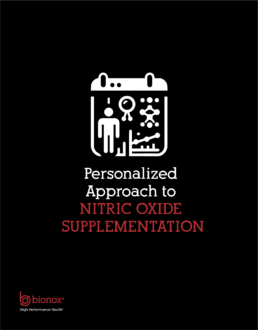
The Role of Nitric Oxide in Heart Health
Nitric oxide (NO) is crucial in maintaining heart health, acting as a key regulatory molecule in the cardiovascular system. Its importance can’t be overstated, and understanding its functions can provide insights into how lifestyle and dietary choices can influence heart health.
Nitric oxide is a vasodilator, meaning it helps relax and widen blood vessels, improving blood flow and reducing blood pressure. This is critical for preventing conditions like atherosclerosis (the hardening of arteries). Why? Because atherosclerosis is a major risk factor for heart attacks and strokes.
One of the fascinating aspects of nitric oxide is its production within the body. It’s synthesized from L-arginine, an amino acid, by the enzyme nitric oxide synthase. L-Citrulline can also have the same effect. This process can be influenced by various factors, including diet and exercise. Foods rich in nitrates, such as beets and leafy greens, can boost nitric oxide levels. Additionally, regular physical activity has enhanced the body’s ability to produce nitric oxide.
Diminishing Returns
With age and certain health conditions and foods, the production of nitric oxide can diminish. This is bad, leading to an increased risk of cardiovascular diseases, high blood pressure, and more. This makes it even more important to focus on nitric oxide-boosting habits as part of a heart-healthy lifestyle.
The role of nitric oxide extends beyond just vasodilation. It also has anti-inflammatory and antiplatelet properties. These properties further protect against the development of heart diseases. By preventing platelet aggregation and adhesion, nitric oxide helps reduce the risk of blood clots forming within the arteries.
Nitric Oxide Is Vital
Nitric oxide is a vital molecule for cardiovascular health, influencing blood pressure, blood flow, and overall heart function. A heart-healthy lifestyle that includes a diet rich in nitric oxide-boosting foods and regular exercise can help maintain optimal levels of this crucial molecule.
For more detailed information, you can refer to the following sources:
- American Heart Association: Nitric Oxide and Heart Health
- National Institutes of Health: Nitric Oxide and Cardiovascular Health
- Journal of Nutrition: Dietary Sources and Bioactivities of Nitric Oxide
These sources offer in-depth insights into the role of nitric oxide in heart health and how it can be influenced by diet and lifestyle.
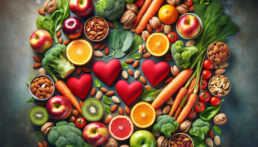
When it comes to maintaining a heart-healthy diet, the type of protein you consume is just as important as the quantity. Incorporating a variety of lean proteins into your diet is not only beneficial for heart health but also contributes to overall well-being. Here’s a deeper look into why choosing lean meats, poultry, fish, low-fat dairy products, eggs, and plant-based proteins is essential for heart health.
Foods For A Heart Health Diet
Lean Meats and Poultry: Lean meats, particularly cuts that are lower in saturated fat, can be a healthy part of your diet. For instance, choosing skinless chicken or turkey breasts over fattier cuts or processed meats can significantly reduce your intake of unhealthy fats.
Fish – A Heart-Healthy Choice: Fish, especially those rich in omega-3 fatty acids like salmon, mackerel, and herring, are particularly beneficial for heart health. Omega-3 fatty acids are known for their role in reducing inflammation throughout the body, lowering blood pressure, decreasing triglyceride levels, and even reducing the risk of stroke and heart failure. The American Heart Association recommends eating two servings of fish per week, particularly fatty fish, for these benefits.
Dairy Options
Low-Fat Dairy Products: Dairy products are good sources of protein and other essential nutrients. Opting for low-fat or fat-free dairy options helps reduce the intake of saturated fats. These fats are known to raise LDL (bad) cholesterol levels. Products like skim or 1% milk, low-fat yogurt, and cheese are healthier choices that contribute to a balanced diet.
Eggs: Once controversial due to their cholesterol content, eggs are now considered part of a heart-healthy diet. They are a versatile source of high-quality protein and contain various essential nutrients.
Plant-Based Proteins: For those looking to reduce their meat intake, plant-based proteins offer an excellent alternative. Legumes (beans, lentils, chickpeas) and soy products (tofu, tempeh, soy milk) are not only good protein sources but also contain fiber, vitamins, and minerals. These foods can lower cholesterol levels and are associated with a reduced risk of heart disease.
In Conclusion
In conclusion, varying your protein sources and focusing on lean meats, fish rich in omega-3 fatty acids, low-fat dairy, eggs, and plant-based proteins can significantly impact your heart health. This approach offers a balanced intake of essential nutrients while minimizing the risk factors associated with heart disease.
For more detailed information, check out the following sources:
- American Heart Association: Guidelines on protein intake for heart health.
- Harvard School of Public Health: In-depth look at various protein sources and their health impacts.
- Mayo Clinic: Information on healthy fats and omega-3 fatty acids in fish.
These resources provide comprehensive insights into how different proteins affect heart health. They also show how to incorporate them into your diet effectively.
Salt (Sodium) Intake
High salt consumption is linked to hypertension, a major risk factor for heart disease. The American Heart Association suggests limiting sodium to no more than 2,300 milligrams per day.
Salt, or sodium chloride, is a staple in many diets worldwide. Its excessive consumption poses significant health risks, particularly for heart health. One of the primary concerns associated with high salt intake is its strong link to hypertension. High blood pressure a major risk factor for heart disease.
Hypertension is often labeled as a “silent killer”. This is because it typically has no symptoms but significantly increases the risk of heart attack, stroke, and death. Sodium plays a key role in this process. It affects the balance of fluid in the body and the function of blood vessels. When you consume too much sodium, your body holds extra water to “wash” the salt from your body. This then increases the volume of blood inside your blood vessels. This, in turn, raises blood pressure.
Risks Of High Sodium Intake
Recognizing the risks associated with high sodium intake, the American Heart Association (AHA) recommends limiting sodium. They say no more than 2,300 milligrams per day should be consumed. However, they suggest an ideal limit of no more than 1,500 mg per day for most adults. They say this is especially true for those who have high blood pressure or are at risk of developing it.
Reducing salt intake isn’t just about using less table salt. It’s also crucial to be aware of the sodium content in various foods, especially processed and prepared foods, which can be significant sources of hidden sodium. Reading food labels, choosing lower-sodium products, and preparing meals at home where you can control the amount of salt used are effective strategies for reducing sodium intake.
Furthermore, increasing the consumption of potassium-rich foods, such as fruits and vegetables, can counteract the effects of sodium and help lower blood pressure. Potassium helps to ease tension in your blood vessel walls, which helps further lower blood pressure.
To Sum This Up
Moderating sodium intake is a key component of a heart-healthy diet. It helps in preventing and controlling hypertension, thereby reducing the risk of heart disease. For those with existing high blood pressure, heart conditions, or a family history of these issues, it’s particularly important to be vigilant about sodium consumption.
For more detailed information and guidance on sodium intake and heart health, you can refer to the following sources:
- American Heart Association: Sodium and Your Heart
- Centers for Disease Control and Prevention (CDC): Sodium and High Blood Pressure
- Harvard T.H. Chan School of Public Health: Sodium and Potassium
These resources offer comprehensive insights into the impact of sodium on heart health and practical advice on managing sodium intake for a healthier lifestyle.

Discover the Power of Ultimate Nitric Oxide Nutrition: A Heart Health Diet Journey
Imagine waking up each day with a renewed sense of vitality and well-being, knowing you’re taking a crucial step towards maintaining your heart health. This isn’t just a dream—it’s a reality made possible by the transformative power of Ultimate Nitric Oxide Nutrition.
The Story of John: A Heart Health Revolution
Meet John, a 45-year-old who, like many of us, juggled a busy lifestyle, family responsibilities, and a demanding job. Despite his best efforts, John struggled with maintaining a balanced diet and regular exercise. He knew his heart health needed attention, but the path wasn’t clear—until he discovered Ultimate Nitric Oxide Nutrition.
John’s journey began with understanding the critical role of Nitric Oxide (NO) in cardiovascular health. NO, a miraculous molecule produced within our bodies, is a key player in maintaining healthy blood flow and blood pressure. However, like many adults, John’s natural NO production was declining with age, posing a risk to his heart health.
Ultimate Nitric Oxide Nutrition
Enter Ultimate Nitric Oxide Nutrition—the game-changer in John’s story. This meticulously formulated supplement offered an easy and effective way to boost his body’s NO levels. With a blend of L-arginine, L-citrulline, and other heart-healthy nutrients, Ultimate Nitric Oxide Nutrition was not just a supplement; it was a beacon of hope for John.
The Transformation: A Healthier, Happier Heart
Within weeks of integrating Ultimate Nitric Oxide Nutrition into his daily routine, John noticed remarkable changes. His energy levels were higher, he felt more active, and, most importantly, his heart health markers showed significant improvement. The supplement, alongside his efforts to eat better and stay active, made a real difference.
John’s story isn’t unique. Countless individuals have turned to Ultimate Nitric Oxide Nutrition as a cornerstone of their heart health strategy. This supplement isn’t just about preventing issues; it’s about empowering your heart, enhancing blood flow, and embracing a healthier lifestyle.
Your Heart Health Partner
Ultimate Nitric Oxide Nutrition is more than just a supplement; it’s your partner in the journey towards optimal heart health. Whether you’re looking to proactively support your cardiovascular system, improve your workout performance, or seek a boost in overall well-being, Ultimate Nitric Oxide Nutrition is the key.
Embark on Your Heart-Healthy Journey Today
Don’t wait for a wake-up call to start taking care of your heart. Embrace the power of Ultimate Nitric Oxide Nutrition and join the ranks of individuals like John who have transformed their heart health. Visit Bionoxusa.com to learn more and take the first step to a healthier heart.
Remember, every journey begins with a single step. Make Ultimate Nitric Oxide Nutrition that steps towards a healthier, happier heart.
Detoxing Microplastics, Metal, and Vaccine contamination
Detoxing any time soon? The growing concern surrounding microplastics, metal contamination, and vaccine contamination is pushing people to find effective ways to protect themselves from these potential hazards. This article will explore various natural ingredients known for their detoxifying and health-supporting properties. These ingredients can help rid the body of unwanted toxins and heavy metals, support immune system function, and maintain overall health.
Natural Chelators and Detoxifiers
EDTA (Ethylenediaminetetraacetic Acid): EDTA is a synthetic amino acid that has ben shown to effectively bind to heavy metals in studies, such as lead, mercury, and cadmium, and helps remove them from the body.
EDTA chelation therapy has been used to treat heavy metal poisoning, cardiovascular disease, and other health conditions related to toxic metal buildup. It has been shown to have an impact on Nitric Oxide Synthase production, health and other important factors.
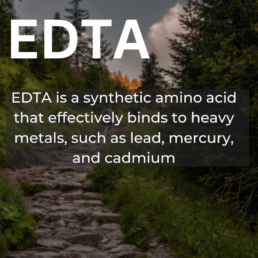
Chlorella Algae: Chlorella is a type of single-celled green algae known for its detoxifying properties. It is rich in chlorophyll, which binds to heavy metals and helps remove them from the body. Additionally, Chlorella supports the immune system, aids digestion, and promotes overall well-being.
EDTA Is A Natural Ingredient
Since it is a natural ingredient, using it daily in a chelation therapy supplement is a no brainer, as it has no downside. It has nutritional value, other benefits for your health, too many to get into, and is an easy and affordable means to support your nitric oxide synthase pathways.
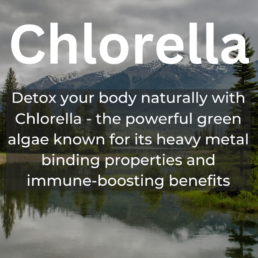
Modified Citrus Pectin: Modified Citrus Pectin (MCP)
MCP is a soluble fiber derived from citrus fruits. It has been shown to bind to heavy metals, such as lead and mercury, and help remove them from the body. MCP also supports digestive health, helps maintain healthy cholesterol levels, and has potential anti-cancer properties according to some studies.
Several studies and reviews have indicated that Modified Citrus Pectin (MCP) may have anti-cancer properties. Here are some key findings from various sources:
- General Potental Anti-Cancer Properties: MCP is recognized as a dietary supplement with potential in oncology. It has shown abilities in anti-cancer, anti-metastases, immune-boosting, and heavy metal detoxification. Specifically, MCP blocks Galactin-3, an important inflammatory compound, and may enhance the effectiveness of chemotherapy drugs. Research suggests that MCP can help reduce metastases in prostate and other cancers, reducing the proliferation of cancer cells both in vitro (in test tubes) and in vivo (in living organisms).
- Therapeutic Agent for Various Conditions: MCP, derived from citrus peels, is recommended as a therapeutic agent not only for immune support but also possibly for for cancer, heavy metal toxicity, and fibrotic diseases. This indicates a broad spectrum of potential health benefits, including its potential role in cancer therapy.
- Inhibitory Effect on Liver Metastases: In a study focusing on a mouse colon cancer model, modified citrus pectin demonstrated an inhibitory effect on liver metastases. This suggests its potential effectiveness in reducing the spread of cancer to the liver from other areas.
- Beneficial Effects on Colon and Breast Cancer: Data suggest that MCP, specifically, is beneficial in the development and spread of malignancies, particularly in colon and breast cancer. This further adds to its profile as a bioactive food polysaccharide with potential cancer-preventive properties.
- Chemopreventive and Antitumoral Activities: Both pectin and pH- or heat-modified pectin have shown chemopreventive and antitumoral activities against some aggressive and recurrent cancers. This review focuses on how these forms of pectin display these activities and explores the possible underlying mechanisms.
MCP Has Immune Modulating Effects
These studies and reviews highlight the growing interest in MCP as a natural substance with potential anti-cancer properties. While more research is needed to fully understand its mechanisms and efficacy in humans, the current findings are promising and suggest a potential role for MCP in cancer prevention and treatment. We are in no way saying that this is a cure, or our product can cure or have any effect on cancer. Our goal is to merely point out the research, possible implications and health benefits.
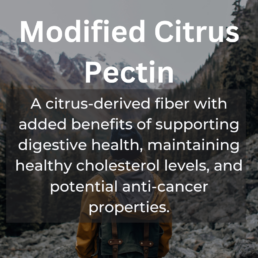
Leaf Extract : Cilantro
Cilantro a popular culinary herb, contains compounds that bind to heavy metals and facilitate their removal from the body. The Cilantro leaf’s extract has been used as a natural chelator to support detoxification processes, particularly for mercury and lead.
-
Detoxification
Cilantro is known for its potential detoxifying effects, particularly those related to removing heavy metals from the mammalian / human body. Compounds that are commonly found in cilantro may bind to common toxic metals like lead, arsenic, and mercury, aiding in their elimination from the body via natural means.
-
Antioxidant Properties
Cilantro contains powerful and useful antioxidants, which can help protect the body against damage from free radicals, nasty little things that you for sure do not want! These antioxidants include quercetin, tocopherols, and terpenoids, which contribute to reducing oxidative stress and may help prevent certain chronic diseases and can also help extend the life of nitric oxide, an important nutrient/chemical vital for cardiovascular health!
-
Anti-inflammatory Effects
Cilantro has been found to have anti-inflammatory properties. Chronic inflammation is a root cause of many health conditions, if not most of today’s biggest diseases, so consuming foods with anti-inflammatory properties like cilantro can be beneficial for overall health and common sense disease prevention.
-
Digestive Health
Cilantro can aid in digestion and may help in settling an upset stomach. It has been used traditionally for its digestive benefits, helping with indigestion, flatulence, and bloating.
-
Antimicrobial Properties
Some studies suggest that cilantro has antimicrobial properties, meaning it can help fight against certain bacteria and fungi. This can be beneficial in preventing foodborne illnesses when cilantro is used in cooking.
-
Heart Health
Cilantro may have a positive effect on heart health. It can help lower bad cholesterol (LDL) levels and increase good cholesterol (HDL). Also, its antioxidants may help in preventing damage to the heart and blood vessels.
-
Blood Sugar Regulation
There is some evidence that cilantro may help in managing blood sugar levels, making it a potentially beneficial herb for people with or at risk of diabetes.
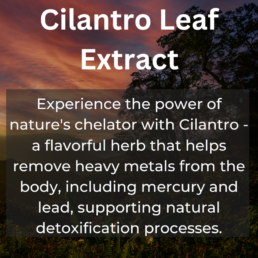
Shilajit Extract: Shilajit is a natural resinous substance found in the Himalayan mountains. It is rich in fulvic acid, a powerful detoxifying agent that binds to heavy metals and other environmental toxins, helping to remove them from the body. Shilajit also supports energy production, cognitive function, and overall vitality.

Immune System and Liver Support & Detoxing
Amazing Zeolite
Zeolite is a group of microporous minerals with a unique cage-like structure, which allows it to trap and remove heavy metals and other toxins from the body. Zeolite has been used to support detoxification, improve immune function, and promote overall health.
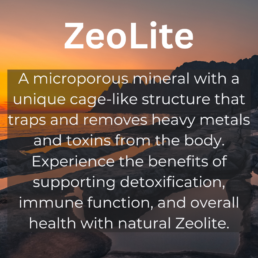
Glutathion & NAC
Glutathione is a powerful antioxidant that is crucial in detoxification and immune system function. The Glutathione Precursor Support Blend provides the necessary amino acids (glutamic acid, cysteine, and glycine) to help the body produce glutathione, thus supporting detoxification and immune health.
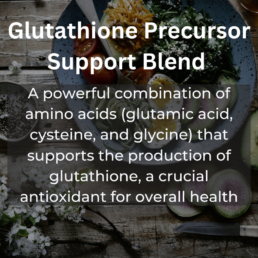
Alpha Lipoic Acid: Alpha Lipoic Acid
(ALA) is a potent antioxidant that helps neutralize free radicals and supports the body’s natural detoxification processes. ALA also assists in regenerating other antioxidants, such as vitamin C and glutathione, further enhancing the body’s defense against toxins and oxidative stress.
Uva Ursi Leaf Powder
Uva Ursi is an herbal remedy with a long history of use for its diuretic and urinary tract health-supporting properties. It is also believed to help remove toxins and heavy metals from the body through increased urine production.
Milk Thistle Seed Powder
Milk Thistle is a well-known herb that supports liver health and detoxification. Its active compound, silymarin, has been shown to protect liver cells from damage and promote the regeneration of damaged liver tissue. Milk Thistle can help the body effectively process and eliminate toxins and heavy metals by supporting liver function.
Supporting the Detoxification Process
Cellulose Capsule: Cellulose capsules are a plant-based alternative to traditional gelatin capsules, providing a suitable option for vegetarians and vegans. These capsules can protect sensitive ingredients from stomach acid, ensuring their release in the small intestine for maximum absorption and effectiveness.
Conclusion
As concerns about microplastics, metal contamination, and vaccine contamination continue to rise, incorporating natural detoxifying ingredients into one’s daily routine can help support the body’s natural ability to eliminate toxins and heavy metals. The combination of chelators, immune system supporters, and liver-supporting ingredients discussed in this article can provide a comprehensive approach to maintaining overall health and well-being in the face of environmental challenges.
How To Boost The Nitrates in Beetroot & Vegetables
How can you boost the nitrates in beetroot and vegetables, and why should you care? Let’s dive right in and find out!
Understanding Nitrates in Beetroots & Veggies
Nitrates are essential chemical and nutritional components in plants, especially in beetroots and arugula, both contributing significantly to their nutritional and health-promoting profile.
In the body, nitrates from beetroots and other veggies like arugula are converted into nitric oxide, which plays a crucial role in cardiovascular health, immune health, and brain function and is known for lowering blood pressure and improving blood flow.
There are literally thousands of studies on the benefits of nitric oxide from many sources like arginine, citrulline, and beetroot. If you like to garden, it makes a lot of sense to learn how you can increase the amount of nitrate in your food since it offers so many incredible health benefits.
Beetroot & Nitrates
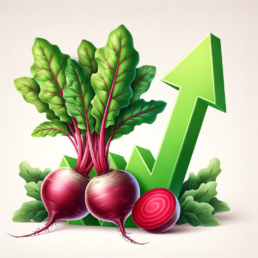
High Nitrate Veggies
Arugula (Rocket)
Arugula is renowned for its very high nitrate levels, making it one of the top vegetables in this category.
Ideal Growing Conditions: Arugula prefers moderate to cool climates. It is versatile and can be grown in various regions across the United States, especially those with mild winters.
Beetroot
Beetroots are well-known for their substantial nitrate content, which benefits health.
Ideal Growing Conditions: Beetroots grow best in cooler climates. They are adaptable and can thrive in many areas across the U.S., particularly in regions with temperate climates.
Celery
Celery is another vegetable with a high concentration of nitrates, alongside being a low-calorie and high-water-content vegetable.
Ideal Growing Conditions: Celery requires a long growing season and consistent moisture. It grows well in regions with steady temperatures and ample water supply, which can be found in various parts of the United States.
These vegetables, with their high nitrate content, have diverse growing requirements, so almost anyone reading this article should be able to grow at least one of these.
Arugula’s ability to adapt to a range of climates, beetroots’ preference for cooler temperatures, and celery’s need for a consistent, moist environment illustrate the variety of conditions needed to grow and cultivate these nutrient-rich vegetables successfully.
To enhance the nitrate content in vegetables such as arugula, beetroot, and celery, it’s essential to focus on effective soil management and various fertilization techniques.
Here’s an integrated approach to increasing the nitrate content in your garden produce, aiming to boost overall health benefits:
Nitrogen-Rich Fertilization
Select fertilizers high in nitrogen since nitrates are a form of nitrogen absorbed by plants. Options like calcium nitrate, potassium nitrate, or ammonium nitrate are effective. Organic alternatives such as blood meal or fish emulsion, also rich in nitrogen, can be used. It’s important to apply these fertilizers regularly as per the manufacturer’s guidelines. Leafy greens like arugula might require more frequent applications to maintain high nitrate levels and support rapid growth.
Soil Management
Regular soil testing is a key step in monitoring nitrate levels, allowing you to adjust your fertilization strategy effectively. Nitrates are crucial for healthy plant growth, and understanding their levels in your soil is fundamental.
Maintaining a soil pH between 6.0 and 7.0 helps maximize nitrogen availability for most vegetables. Adding organic matter such as compost or well-rotted manure improves soil structure and microbial activity, aiding in converting organic nitrogen sources to nitrates.
Irrigation Practices
Consistent watering is vital, as water stress can affect a plant’s ability to absorb nitrates. However, it’s equally important to avoid overwatering, which can cause the leaching of nitrates from the soil, reducing their availability to plants.
Crop Rotation
Incorporating nitrogen-fixing crops like legumes in your crop rotation can enhance the nitrogen content of the soil for the subsequent growing season, benefiting the next crop in terms of nitrate availability.
Harvest Timing
Harvesting your vegetables at the right time is crucial. Younger arugula leaves or medium-sized beetroots often have higher nitrate concentrations than over-matured ones. Since commercial farms are interested in larger-size veggies as they sell for more money, this is yet another reason why growing your own is advisable.
Mulching
Applying organic mulch around the plants is beneficial. Mulch helps maintain soil moisture and temperature, fostering better absorption of nitrates by the plants.
Controlled Environment Growing
Consider using controlled environments such as hydroponic systems or greenhouses. These settings allow for precise control of nutrient levels, including nitrogen, which can lead to higher nitrate concentrations in the plants.
By adopting these strategies, you can effectively increase the nitrate content in vegetables like arugula, beetroot, and celery, enhancing their nutritional value and contributing to a healthier diet.
Arugula Can Be Very High In Nitrates





